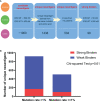An EGFR L858R mutation identified in 1862 Chinese NSCLC patients can be a promising neoantigen vaccine therapeutic strategy
- PMID: 36505399
- PMCID: PMC9727402
- DOI: 10.3389/fimmu.2022.1022598
An EGFR L858R mutation identified in 1862 Chinese NSCLC patients can be a promising neoantigen vaccine therapeutic strategy
Abstract
Background: This study aimed to develop a vaccine that targets mutation-derived neoantigen in Chinese non-small-cell lung cancer (NSCLC).
Methods: A cohort of 1862 Chinese NSCLC patients who underwent targeted sequencing with a 1021-gene panel was investigated. HLA typing was done using OptiType v1.0 and neoantigens were predicted by netMHCpan v4.0. HLA LOH was inferred using the lohhla algorithm and TMB were quantified by counting the total number of non-synonymous ones based on our panel data. CIBERSORT was utilized to estimate the TME in different EGFR mutant subtype by using TCGA data.
Results: HLA-A*11:01(42.59%) was the top one allele and HLA-A*33:03(12.94%) ranked 12th. EGFR L858R (22.61%) was the most prevalent gene variant. The binding affinity (IC50 MT = 22.9 nM) and shared frequency (2.93%) of EGFR L858R in combination with HLA-A*33:03 were optimal. In a subsequent further analysis on immunological features of EGFR mutant subtypes, 63.1% HLA loss of heterozygosity LOH (HLA LOH) and 0.37% (7 of 1862) B2M aberrations were found in our population, both had no significant association with EGFR mutant subtypes suggesting that the process of antigen presentation involved HLA LOH and B2M mechanisms in EGFR L858R is working. Tumor mutation burden (TMB) was investigated by utilizing our panel and showed that EGFR L858R had the lowest TMB compared with other EGFR mutant subtypes. In addition, analysis of 22 immune cell types from The Cancer Genome Atlas (TCGA) data showed EGFR L858R was correlated with low level of CD8 T cells, activated CD4 memory T cells and elevated level of macrophage M2 suggesting an inhibited tumor microenvironment (TME).
Conclusion: Our study identified that EGFR L858R neoantigen had the potential to generate cancer vaccines in NSCLC patients with HLA A*33:03. The neoantigen-based vaccines may become an effective salvage regimen for EGFR L858R subgroup after targeted therapy or immune checkpoint inhibitors (ICIs) failure.
Keywords: Chinese NSCLC; EGFR L858R mutation; HLA A*33:03; immunological features; neoantigen vaccine.
Copyright © 2022 Lin, Liu, Hao, Lan, Zheng, Xiong, Zhang, Gao, Chen, Chen, Huang, Luo, Yi, Yi, Lu, Zheng, Chen, Wang and Chen.
Conflict of interest statement
Authors S-GH, Y-QZ, XG, Y-TY, and XY were employed by company Geneplus. The remaining authors declare that the research was conducted in the absence of any commercial or financial relationships that could be construed as a potential conflict of interest.
Figures








References
MeSH terms
Substances
LinkOut - more resources
Full Text Sources
Medical
Research Materials
Miscellaneous

